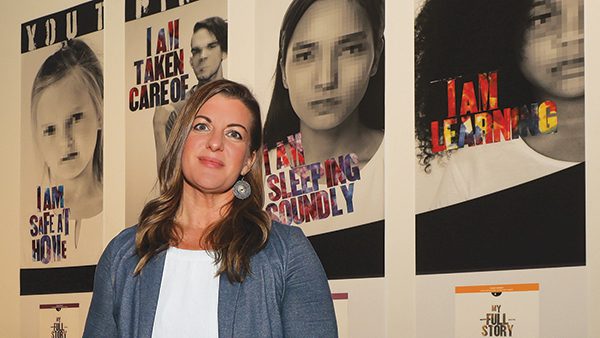
5 Questions with paige dean
Grad student and communications instructor, Paige Dean, has been studying the long-term effects of childhood sexual abuse (CSA) and is an advocate for CSA prevention. Last December, she unveiled four large-format advocacy posters that were on display at the Heuser Art Center Gallery.
1. How does your work tie into studying the long-term effects of CSA?
When I started discussing the potential of grad school with my colleagues in the Communications Department, they wanted to know the focus of my thesis. I have been a professional in the advertising and public relations field for 17 years working in many capacities from corporate to nonprofit, and now teaching for several years, so I didn’t want to necessarily revisit what I’ve already done. I wanted to choose a topic about something I am passionate about, to learn and grow—for not only myself, but also to potentially use my visual communications skills to advocate for others. My thesis focuses on the long-term effects of childhood sexual abuse (CSA).
2. How did you become such an advocate for CSA prevention?
Between the ages of 6 and 13, I was personally affected by CSA, and continue to struggle with the longterm effects. In studying CSA and working closely with the Center for Prevention of Abuse (CFPA) in Peoria, I learned invaluable information I can apply to my own personal healing and growth, and to help promote CSA awareness and prevention. The statistics revolving around CSA are staggering, and as a parent I learned our best defense in protecting children is knowledge—knowing what signs to look for in children and what language to use when discussing body safety. There is such a stigma around this topic. I know it is uncomfortable for people to talk about, but frankly it is not talked about enough.
3. Why is it important to use art as a tool in advocacy
Creating art in any capacity has proven to give people a healthy escape—an outlet for expressing their emotions in a safe, non-verbal way. During the fall semester of my first year of grad school, I played around with an ink and alcohol technique that I found to be incredibly relaxing and healing. This was therapy! I would spend hours creating pieces, trying new techniques, color variations and different materials. I was mesmerized not only by how beautiful the end results would be, but also by how forgiving the art form was. As a survivor myself, having found peace and growth through this particular form of art made me want to share it with other survivors. The path of sharing has now led me to teaching art wellness classes at the CFPA, using this technique.
4. What do you hope your students take from your teachings?
I teach graphic design, advertising and public relations. These courses are creative, yet functional, providing a hands-on lab style environment for students who are otherwise used to lecture-based classes. It’s more relaxed and inviting, and offers a refreshing change of pace. Students are finally able to meld communication strategy, research and copywriting with creative visuals for print and digital media. At the end of each semester, my students take away a skill set that is invaluable as they enter the field of communication.
5. What is next on the horizon for you?
Well, I absolutely love teaching and it is incredibly rewarding. There is also a part of me that misses designing for the advertising and marketing industry. I enjoy the pace of the corporate environment— working with a team, brainstorming and executing visuals. I am not sure where my career will take me post grad school, but I do know that whatever it is, it will need to be creative, challenging and rewarding!

